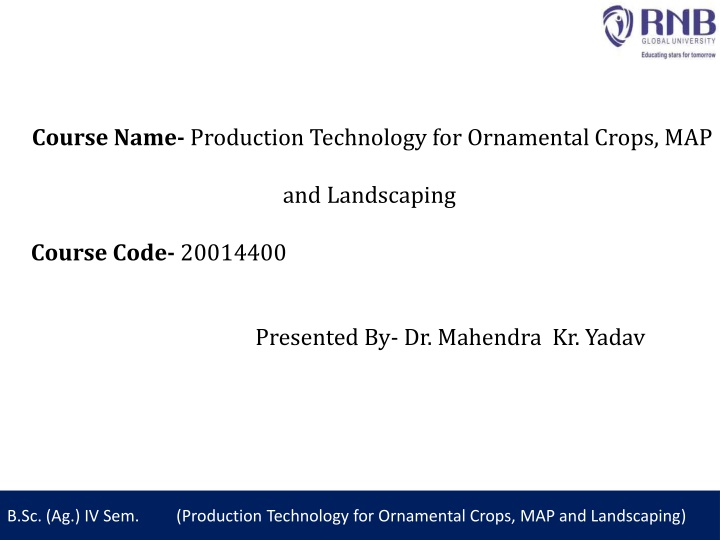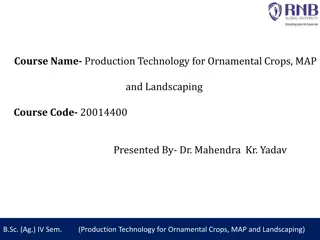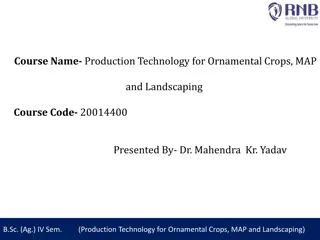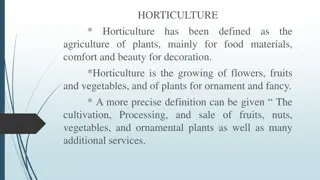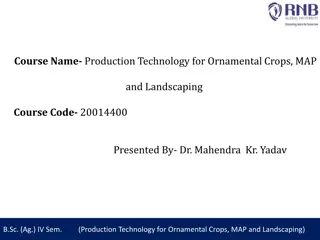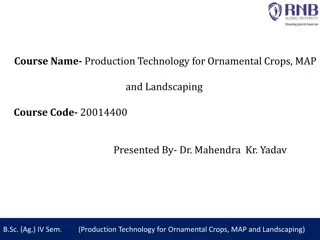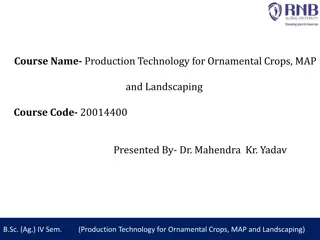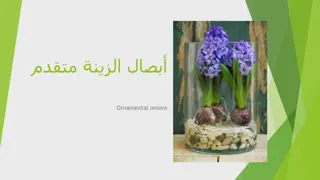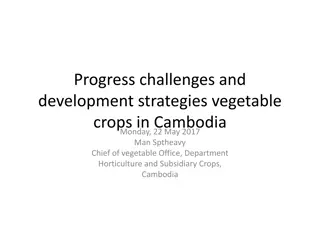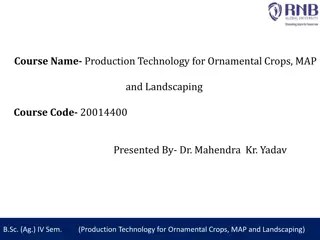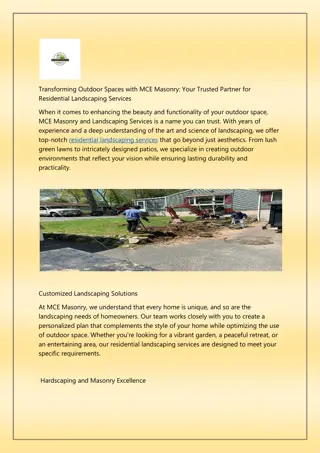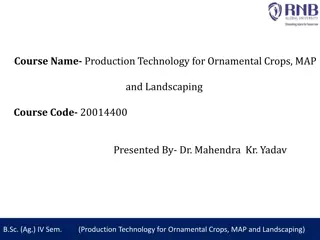Production Technology for Ornamental Crops and Landscaping Overview
Explore the world of ornamental crops, medicinal plants, and landscaping with Dr. Mahendra Kr. Yadav's Production Technology course. Learn about different crop types, landscaping principles, flower production practices, and the importance of value addition. Delve into ornamental horticulture, floriculture, commercial floriculture, and more. Discover the beauty of loose flowers, foliage plants, gardens, and landscape gardening in this comprehensive study.
Download Presentation

Please find below an Image/Link to download the presentation.
The content on the website is provided AS IS for your information and personal use only. It may not be sold, licensed, or shared on other websites without obtaining consent from the author.If you encounter any issues during the download, it is possible that the publisher has removed the file from their server.
You are allowed to download the files provided on this website for personal or commercial use, subject to the condition that they are used lawfully. All files are the property of their respective owners.
The content on the website is provided AS IS for your information and personal use only. It may not be sold, licensed, or shared on other websites without obtaining consent from the author.
E N D
Presentation Transcript
Course Name- Production Technology for Ornamental Crops, MAP and Landscaping Course Code- 20014400 Presented By- Dr. Mahendra Kr. Yadav B.Sc. (Ag.) IV Sem. (Production Technology for Ornamental Crops, MAP and Landscaping)
Course Objectives Identify different types of ornamental and medicinal crops. Examine various principles of landscaping, uses of landscape trees, shrubs and climbers, production technology of important ornamental crops, etc. Determine about Demonstrate various Package of practices for loose flowers and their transportation, storage house and required condition for cut and loose flower. Construct about the various problems with the production technology of medicinal and aromatic plants. Importance of Processing and value addition in ornamental crops and MAPs produce. B.Sc. (Ag.) IV Sem. (Production Technology for Ornamental Crops, MAP and Landscaping)
Importance and scope of ornamental crops medicinal and aromatic plants and landscaping Dr. Mahendra Kr. Yadav B.Sc. (Ag.) IV Sem. (Production Technology for Ornamental Crops, MAP and Landscaping)
Ornamental Horticulture: It is a branch of horticulture that deals not only with the cultivation of flowers but also the decorative foliage plants, trees, shrubs, climbers, creepers, lawn, cacti, succulents, palms, ferns, bonsai and also with their marketing and production of value-added products from them. Floriculture: It is an art and science of growing flowers to perfection. It can be defined as a specialized branch of horticulture which deals not only with the cultivation of flowers, foliage, climbers, trees, shrubs, cacti, succulents,etc., but also with their marketing and production of value-added products from them. Commercial Floriculture: The floriculture which is based on flower production, which is high value added flowers. When export is done, it is known as commercial floriculture. Cut Flower: Cut flowers are fresh flower harvested in clusters / spike or in single along with their stem. B.Sc. (Ag.) IV Sem. (Production Technology for Ornamental Crops, MAP and Landscaping)
Loose Flower: The flowers which are usually harvested without stalk and used for Gajara, Veni and Garland. Foliage plants/trees: These are those plants/trees whose foliage particularly leaves or branches are so attractive and can also be used as a house plant for indoor decoration as well as for outdoor gardening. Garden: A garden is an area adjunct to the house or any building especially made for the purpose of refreshment and recreation. Landscape: A landscape may be defined as any area, either big or small, on which it is possible to mould a view or design with the help of plant material, changing landform, water, stones, etc. Landscape Gardening: The application of garden forms, different styles, methods & materials with a view to improving the landscape. B.Sc. (Ag.) IV Sem. (Production Technology for Ornamental Crops, MAP and Landscaping)
Medicinal plants: Medicinal plants are those plants rich in secondary metabolites and are potential sources of drugs. These secondary metabolites include alkaloids, glycosides, coumarins, flavanoids, steroids etc. eg. Ashwagandha, senna, safed musli, etc. Aromatic Plants: These plants possess essential oil in them. These essential oils are the odoriferous steam volatile constituents of the aromatic plants. eg. lemongrass, citronella, palmarosa, mint, etc. Importance and Scope of Ornamental Crops Besides food and nutritional security, the aesthetic value is also equally important for our daily lively hood as well as for environmental purity. Floriculture is important from the following point of view; Economic point of view 1. Aesthetic point of view 2. Social point of view 3. B.Sc. (Ag.) IV Sem. (Production Technology for Ornamental Crops, MAP and Landscaping)
1. Economic point of view: Floriculture is a fast emerging major venture in the world, especially as a potential money- spinner for many countries in world. Many flowers and ornamental plants are being grown for domestic as well as for export market will provide more return/unit area Gestation period of flower crop is very less compared to other crops. Now days, flower arrangements/decorations for bouquets preparation and for floral baskets, have increased substantially and its share of the total trade has also improved. The present trend in floriculture is for making dry flowers, extraction of natural colours and essential oils. There is lot of demand for good quality flower seeds and ornamental planting materials. Floriculture generates self-employment opportunities round the year B.Sc. (Ag.) IV Sem. (Production Technology for Ornamental Crops, MAP and Landscaping)
1. Aesthetic point of view: The wealth of any nation is linked with the health of its people. Unless we can ensure the healthy development of our citizens, especially for the younger generation, by providing them for open breathing places through bio-aesthetic planning like in Chandigarh city and landscape gardening, we cannot expect to build up a healthy society and prosperous nation. Horticultural therapy is the new dimension of horticultural sciences to heal the psychic debility and the science is to use garden, landscape plants, as a new occupational therapeutic tool to restore the lost rhythm and harmony back to human It is being utilized in psychiatric hospitals, general hospitals and physical rehabilitation centres, homes for elderly, prisons and schools. The patients can achieve higher level of personal development and satisfaction. B.Sc. (Ag.) IV Sem. (Production Technology for Ornamental Crops, MAP and Landscaping)
3. Social point of view: Flowers symbolize the purity, beauty, peace, love, adoration, innocence and passion etc. Hence, many flowers are used to express the most sensitive, delicate and loving feelings where our words fail to express. In our society no social function is complete without the use of flowers, floral ornaments, bouquets or flower arrangements they are invariably used in all social functions. Used in social gatherings, birthday parties, welcoming friends or relatives and honoring dignitaries. The arrival of new born is rejoiced with flowers. To an Indian, especially for Hindus, flowers have a much greater significance in religions offerings. Floral garlands, gajras and venis are required in marriage ceremonies for adornment of hairs by women of all ages, especially in the south India. In the present modern era sicks are wished for speedy recovery by offering beautiful cut flowers, while the dead are bidden farewell with flowers along with tear of sorrow. Flowers are very closely associated with mankind from the dawn of human civilization. There is increasing habit of saying with flowers. Any Indians born with flowers live with flowers and finally dies with flowers". B.Sc. (Ag.) IV Sem. (Production Technology for Ornamental Crops, MAP and Landscaping)
Scope of Ornamental Crops in India: India is blessed with varied and dynamic agro-climatic condition, good quality soil and water made suitable for floriculture. Geographically India is well located between two major markets i.e., Europe and East Asia. Winter is being very mild and hence there is lot of scope to export Indian flowers to temperate countries during the winter season, when the demand is in peak because of important winter festivals like Christmas, New Year Day and Valentine s Day. Labour cost is very low in India, nearly 10-15 times cheaper than that of similar employees in the Netherlands, Israel and Japan. The Government of India has identified floriculture as "Extreme Focus Thrust Area" for export during IX plan. With the implementation of GATT agreement European nations has brought down the import duty on floricultural products, which at present is 15 %. The International market is growing @ 8-10 % annually. The International demand is around Rs. 90,000 crore/ year and domestic market at 20-25 %. Hence, the scope to enter floriculture industry in India is unlimited. B.Sc. (Ag.) IV Sem. (Production Technology for Ornamental Crops, MAP and Landscaping)
APEDA is giving financial assistance to some extent for various activities connected with export of floriculture products. Easy bank financing for hi-tech floriculture. 100 per cent tax exemption has given on implements / raw materials used in greenhouses. The rules and regulations related to import and exports have been minimized. Singapore is the nearest International standard flower auction centre, helpful for Indian exports. Floriculture products posses 25-30 time more foreign exchange earning ability than cereals or any other agricultural/horticultural products. Floriculture is capable of attracting and retaining large number of progressive farmers / entrepreneurs. Due to ample sunlight and optimum temperature during winter, it does not require artificial lighting or heating for green house production of cut flowers. The Government of India has identified product specific zones for selective research and development of floriculture. APEDA and GOK have established four flower auction centers including one in Bengaluru, Noida (UP), Mumbai and New Delhi. APEDA also has setup a marketing center at Aalsmeer (The Netherlands) to promote Indian produce. B.Sc. (Ag.) IV Sem. (Production Technology for Ornamental Crops, MAP and Landscaping)
Importance & Scope of Medicinal Plants in India: India is one of the few countries where, almost all the known medicinal plants can be cultivated in some part of the country or the other. Among the various plants from the country and abroad opium poppy, sapogenin bearing yams, senna, psyllium husk and seeds, cinchona are in great demand. The ancient Indian system of medicine (ISM) is predominantly a plant based material medica making use of most of our native plants. It caters to almost the entire rural population of our country mainly because of the scarcity of modern allopathic health care in our villages. ISM offers most appropriate or first line therapy against many diseases like Jaundice, bronchial asthma, rheumatoid arthritis, diabetes etc. For which allopathic medicines have as yet no cure. It is well known that most allopathic medicines produce many morbid side effects. For this reason more and more people in the western societies are showing increasing interest and preference for organic drugs and their preparations. India has about 2000 species of medicinal plants and a vast geographical area with high production potential and varied agro-climatic conditions. Most of these plants can subsist under stress conditions and are thus suited even for rain fed agriculture. Cultivation of medicinal plants offers considerable scope for rural employment and export for foreign exchange earnings. India is already a major exporter of medicinal plants. It is estimated that Rs. 1060 crore worth of raw materials and drugs from medicinal plants are exported from India. It holds monopoly in the production and export of psyllium and senna and is second largest exporter of opium latex. Many medicinal plants required by the trade are gathered mainly from the wild growth, thus depleting the vegetation of its valuable medicinal plant wealth (e.g. Rauvolfia, Dioscorea). On account of this practice, many species of medicinal plants in our country have become extinct or endangered. This should be prevented and herbal gardens and gene-banks covering important medicinal plants should be established to conserve them. B.Sc. (Ag.) IV Sem. (Production Technology for Ornamental Crops, MAP and Landscaping)
Importance & Scope of Aromatic Plants in India: 1. Aromatic plants are from a numerically large group of economically important plants. These are in increasing demand for essential oils, aroma chemicals drugs and pharmaceuticals in the world market since two decades. Aromatic compounds are present in plants i.e. in root, wood, bark, foliage, flower, fruit, seed etc. 2. Aromatic plants produce essential oils, perfumes and flavours are in use with our civilization since several thousand years. 3. Due to vast area and varied agro-climatic condition, they can be commercial cultivated in different part of India successfully. 4. Essential oils and aroma chemicals are indispensable in various human activities. 5. They are adjuncts of cosmetics, soaps, pharmaceutical preparation, perfumer confectionery, ice-cream, aerated waters, disinfectants, agarbatti etc. 6. Some of the important aromatic plants like Lemon grass, Citronella, Palmarose, Vetiver, Geranium, Lavender, Dawana etc. have great demand in our country. 7. Historically, India has enjoyed a pre dominant position as the supplier of natural perfumes in the world. This is true in case of sandalwood oil, lemon grass oil, palmarosa oil, vetiver oil and cedar oil. B.Sc. (Ag.) IV Sem. (Production Technology for Ornamental Crops, MAP and Landscaping)
Importance & Scope of Landscaping: The prime importance of landscape gardening lies in aesthetic developments and modernization of cities, town, countryside, roadways, airports, railway stations, railway lines, bus terminus, city parks, and educational institutions against industrial fast growing pollution. In recent years, bio-aesthetic planning has wider scope in landscape and gardening. Landscape gardening increases the awareness towards nature developed eco- friendly concept and provide feeling of responsibility towards plants, birds and animals. It also serves as a source of live medicines and herbal taste in prepared food and tea. It also helps in soil-moisture retention; prevent erosion, modifying air temperature, creating microclimate and removal of noise and dust pollution. It also provide habitat for birds and animals. One fully developed large tree in a landscape can change the microclimate and brings down the temperature by 2 to 5oC. The average temperature of concrete urban area devoid of vegetation/green belt is higher compile to a thickly vegetated area. B.Sc. (Ag.) IV Sem. (Production Technology for Ornamental Crops, MAP and Landscaping)
Well planned landscape around building or residence adjoins aesthetic value to it as well as affix real estate value of about 30%. The landscaping profession conveys and directs to make human life more elegant, more satisfying, more eco-friendly and more productive. There is unbound scope in the field of landscape gardening with the increase in demand for attractive parks, landscaped ground of schools and institution, pleasant residential backyards, eco-friendly housing society and towns. Landscape flora industry employs thousands of people through various activities like nursery and rental plant services, besides landscape designing. Landscape gardening also plays a vital role in giving emphasis to the tourist business by improving aesthetic and functional uses of historical places, sea beaches, rivers and dams, hill stations and other tourist places. B.Sc. (Ag.) IV Sem. (Production Technology for Ornamental Crops, MAP and Landscaping)
